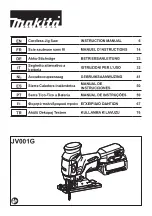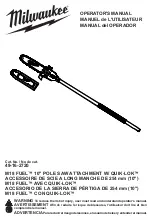
31 ENGLISH
The horizontal vise can be installed in either the left or
right side of the base. When performing 22.5° or greater
miter cuts, install the horizontal vise in the side opposed
to the direction in which the turn base is to be turned.
►
Fig.53:
1.
Vise plate
2.
Vise nut
3.
Vise knob
By flipping the vise nut counterclockwise, the vise is
released, and rapidly moves in and out. To grip the
workpiece, push the vise knob forward until the vise
plate contacts the workpiece and flip the vise nut clock
-
wise. Then turn the vise knob clockwise to secure the
workpiece.
NOTE:
The maximum width of workpiece which can
be secured by the horizontal vise is 228 mm.
Holders
WARNING:
Always support a long workpiece
so it is level with the top surface of the turn base
for an accurate cut and to prevent dangerous loss
of tool control.
Proper workpiece support will help
avoid blade pinch and possible kickback which may
result in serious personal injury.
WARNING:
Before the cutting operation,
always be sure that the holders are secured by
the screws.
To hold long workpieces horizontally, holders are pro-
vided on both sides of the tool. Loosen the screws and
extend the holders to the appropriate length for holding
the workpiece. Then tighten the screws.
►
Fig.54:
1.
Holder
2.
Screw
When cutting, place the workpiece flat against the guide
fences.
►
Fig.55:
1.
Guide fence
2.
Holder
Sub base
Optional accessory
WARNING:
Always support a long workpiece
so it is level with the top surface of the turn base
for an accurate cut and to prevent dangerous loss
of tool control.
Proper workpiece support will help
avoid blade pinch and possible kickback which may
result in serious personal injury.
WARNING:
Before the cutting operation,
always be sure that a sub base is secured by the
screw.
NOTE:
For details on installation, follow the instruc-
tions provided with an optional sub base.
Install an optional sub base in the base to hold long
workpieces more securely. Loosen the screw and
extend the sub base to the appropriate length for hold-
ing the workpiece. Then tighten the screw.
►
Fig.56:
1.
Sub base
2.
Screw
When cutting, place the workpiece flat against the guide
fence and the sub fence on the sub base.
►
Fig.57:
1.
Guide fence
2.
Sub fence
3.
Sub base
Adjusting sub fence
Adjust the sub fence on the sub base if it is not aligned
with guide fence.
1.
Loosen the bolts securing the sub fence using the
hex wrench.
2.
Place a straight rigid bar, such as a square steel
member, flat against the guide fence.
3.
While the bar is flat against the guide fence, repo
-
sition the sub fence so that the face of the sub fence
becomes flat against the bar. After that, tighten the
bolts.
►
Fig.58:
1.
Bolt
2.
Sub fence
3.
Guide fence
4.
Rigid
bar
OPERATION
This tool is intended to cut wood products. With appro-
priate Makita genuine saw blades, following materials
can also be sawed :
— Aluminum products
Refer to our website or contact your local Makita dealer
for the correct circular saw blades to be used for the
material to be cut.
WARNING:
Make sure the saw blade is not
contacting the workpiece, etc. before the switch
is turned on.
Turning the tool on with the blade in
contact with the workpiece may result in kickback and
serious personal injury.
WARNING:
After a cutting operation, do
not raise the saw blade until it has come to a
complete stop.
The raising of a coasting blade may
result in serious personal injury and damage to the
workpiece.
WARNING:
Do not perform any adjustment
such as turning grip, knob, and levers on the tool
while the saw blade is rotating.
Adjustment while
the blade is rotating may result in serious personal
injury.
CAUTION:
Do not release the saw head uncon-
trolled from the fully down position.
Uncontrolled
saw head may hit you and it will result in personal injury.
NOTICE:
Before use, be sure to unlock the stopper
pin and release the handle from the lowered position.
NOTICE:
Do not apply excessive pressure on the han-
dle when cutting.
Too much force may result in overload of
the motor and/or decreased cutting efficiency. Press down
handle with only as much force as necessary for smooth
cutting and without significant decrease in blade speed.
NOTICE:
Gently press down the handle to per-
form the cut.
If the handle is pressed down with force
or if lateral force is applied, the blade may vibrate and
leave a mark (saw mark) in the workpiece and the
precision of the cut may be impaired.
NOTICE:
During a slide cut, gently push the carriage
toward the guide fence without stopping.
If the carriage
movement is stopped during the cut, a mark will be left in
the workpiece and the precision of the cut will be impaired.
Summary of Contents for LS004GZ01
Page 2: ...Fig 1 1 1 2 3 4 5 9 6 7 8 11 10 12 13 14 15 16 17 18 19 20 21 22 23 25 24 26 27 Fig 2 2 ...
Page 3: ...1 2 3 4 5 6 7 8 9 10 12 11 13 14 Fig 3 1 2 Fig 4 1 2 3 4 5 6 Fig 5 3 ...
Page 4: ...1 2 Fig 6 1 2 Fig 7 1 2 3 Fig 8 1 Fig 9 1 1 2 3 Fig 10 1 2 Fig 11 4 ...
Page 5: ...1 2 3 Fig 12 1 2 3 4 Fig 13 1 Fig 14 1 2 3 4 Fig 15 2 1 Fig 16 1 2 3 Fig 17 5 ...
Page 6: ...Fig 18 1 2 3 4 5 6 Fig 19 1 Fig 20 1 2 Fig 21 1 2 Fig 22 Fig 23 6 ...
Page 7: ...1 2 Fig 24 2 3 4 1 Fig 25 3 1 2 Fig 26 1 Fig 27 1 Fig 28 7 ...
Page 8: ...1 Fig 29 1 2 3 4 Fig 30 2 3 4 1 Fig 31 1 2 Fig 32 8 ...
Page 9: ...3 1 2 Fig 33 2 1 3 Fig 34 1 2 3 Fig 35 1 Fig 36 1 2 3 Fig 37 9 ...
Page 11: ...1 2 3 4 5 6 Fig 44 1 2 3 Fig 45 1 2 3 Fig 46 1 Fig 47 1 2 Fig 48 2 1 3 4 2 1 3 4 Fig 49 11 ...
Page 12: ...1 2 3 Fig 50 1 2 3 2 Fig 51 1 2 3 4 Fig 52 2 1 3 Fig 53 2 1 Fig 54 1 2 Fig 55 2 1 Fig 56 12 ...
Page 13: ...1 2 3 Fig 57 1 2 4 4 3 Fig 58 1 Fig 59 1 Fig 60 Fig 61 1 2 3 Fig 62 13 ...
Page 14: ...2 3 1 4 Fig 63 1 2 3 4 Fig 64 1 2 3 4 Fig 65 1 2 Fig 66 1 2 5 3 4 Fig 67 1 Fig 68 Fig 69 14 ...
Page 15: ...Fig 70 1 Fig 71 1 2 3 4 Fig 72 1 2 3 Fig 73 1 Fig 74 15 ...
Page 16: ...1 1 2 2 Fig 75 Fig 76 Fig 77 1 Fig 78 1 2 Fig 79 1 Fig 80 16 ...
Page 17: ...1 Fig 81 1 1 2 2 Fig 82 3 4 5 2 1 Fig 83 1 2 Fig 84 1 2 3 Fig 85 1 2 3 Fig 86 17 ...
















































